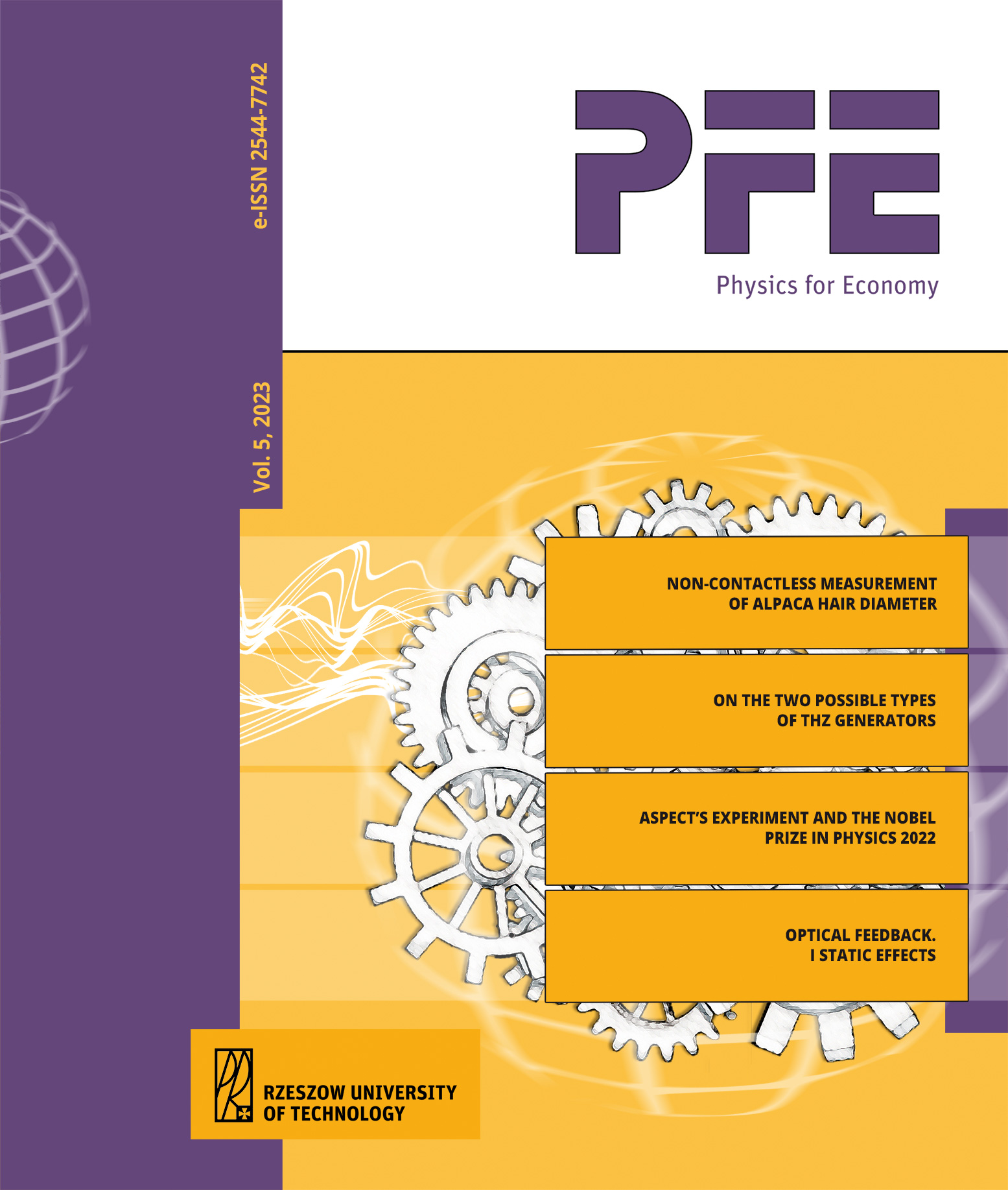Abstrakt
This paper is the review of our study published earlier in Acta Phys. Polon. A 121, 522 (2012) [7], Phys Lett A 378, 1364 (2014) [25], and [1]. It’s aim is to pay attention to the new possibilities related to producing the new types of THz generators. The suggested effects are the result of combining two effects: Gunn-effect in a material such as GaAs and undulator-like radiation, or 'pumping wave' acting on the electrons which is the result of undulator field, while the second is the backward effect of radiation which is produced by electrons moving within such a micro-undulator. It is very probable that the effects can be used to develop a new semiconductor-based room temperature source of the THz-radiation.
Bibliografia
P. Zięba, Active and Passive Elements of GHz and THz - Microelectronics and Optics. PhD Thesis (in Polish) University of Rzeszow, 2015.
A.G. Davies, A.D. Burnett, E.H. Linfield, W. Fan, J.E. Cunningham, Terahertz spec-troscopy of explosives and drugs, Materials Today 11, 18 (2008).
Yun-Shik Lee, Principles of Terahertz Science and Technology, (Springer Science, New York, 2009); B.S. Alexandrov, V. Gelev, A.R. Bishop, A. Usheva, K.O. Ras-mussen, DNA breathing dynamics in the presence of terahertz field, Phys. Lett. A374,1 214 (2010).
D. Dragoman, M. Dragoman, Terahertz fields and applications, Progress in Quant. Electr. 28, 1 (2004).
J.D. Jackson. Classical electrodynamics. John Willey, 1999.
H. Jeffreys, B. Swirles, Methods of Mathematical Physics, 3rd ed., Cambridge University Press, Cambridge 1966.
I. Tralle, P. Zięba, Undulator-like radiation and cooperative phenomenon in semi-conductor microstructure with grating, Acta Phys. Polon. A 121, 520 (2012)
L.I. Schiff, Rev. Sci. Instrum. 17, 6 (1946).
P. Meystre, M. Sargent, III, Elements of Quantum Optics, Springer-Verlag, Berlin 2007.
S.Y. Chou, D.R. Allee, R.F. Pease and J.S. Jr. Harris, Observation of electron reso-nant tunneling in a lateral dual-gate resonant tunneling field effect transistor. Appl. Phys. Lett, 55, 176 (1989).
W.E. Lamb, Theory of an Optical Maser. Phys. Rev. 134, A1429 (1964).
M. Scully, W.E. Lamb, Quantum Theory of an Optical Maser. Phys. Rev. Lett. 16, 853 (1966).
M. Scully, W.E. Lamb, Quantum Theory of and Optical Maser. I. General Theory. Phys. Rev. 159, 208 (1967).
M. Borenstein, W.E. Lamb Jr., Classical Laser. Phys. Rev. A 5, 1298 (1972).
N.W. McLachlan, Ordinary Non-linear Differential Equations in Engineering and Physical Sciences, Clarendon Press, Oxford 1950.
R.H. Dicke, Coherence in spontaneous radiation processes, Phys. Rev. 93 99 (1954).
L. Allen, J. Eberly, Optical Resonance and Two-Level Atoms, Wiley, NY, 1975.
F.T. Arecchi, E. Courtens, Cooperative phenomena in resonant electromagnetic propagation, Phys. Rev.A 2 1730 (1970).
R. Bonifacio, R. Schwendiman, Quantum statistical theory of superradiance I, Phys. Rev. A 4 302 (1971).
R. Bonifacio, R. Schwendiman, F. Haake, Quantum statistical theory of superra-diance II, Phys. Rev. A 4 854 (1971).
M. Gross, P. Goy, C. Fabre, S. Haroche, J.M. Raimond, Maser oscillations and microwave superradiance in small systems of Rydberg atoms, Phys. Rev. Lett. 43 343–346 (1979); L. Moi, P. Goy, J.M. Raimond, C. Fabre, S. Haroche, Rydberg-atom masers. A theoretical and experimental study of super-radiant systems in the millimeter-wave domain, Phys. Rev. A 27 2043 (1983).
L.I. Men’shikov, Superradiation and related phenomena, Phys. Usp. 42 107 (1999).
S. Strogatz, From Kuramoto to Crawford: exploring the onset of synchronization in populations of coupled oscillators, Physica D 143 1 (2000).
J.A. Acebron, L.L. Bonilla, Conrad J. Perez Vicente, Felix Ritort, R. Spigler, The Kuramoto model: a simple paradigm for synchronization phenomena, Rev. Mod. Phys. 77 137 (2005); A. Pikovsky, M. Rosenbluth, and J. Kurths, Synchronization. A Universal Concept in Nonlinear Science. Cambr. Univ. Press, 2001.
I. Tralle, P. Zięba, Induced N2-cooperative phenomenon in an ensemble of the nonlinear coupled oscillators, Phys. Lett. A 378, 1364 (2014).


